 |
 |

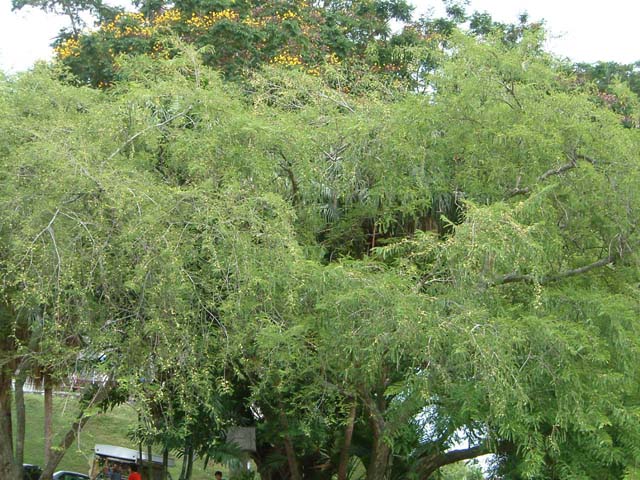 |
| "Malaka tree" Which Is the Origin of the Place Name of Malacca |
| No | Table |
| 1 | Geography、Climate |
| 2 | Population、Race |
| 3 | Political Form |
| 4 | Religion、Language |
| 5 | History |
| 6 | Bumimutera Policy |
| 7 | Traffic |
| 8 | Animals、Plants |
| 9 | Fruit |
| 10 | Industry |
| 11 | School Education |
| 12 | Rerationship with Japan |
| 13 | Return to menu |
|
【Origin of the Place Name Malacca】 Parameswara , the prince of Palembang (southern part of Sumatra) , was attacked by the enemy and moved around. One day , He went hunting with his companion. Tired of exhaustion and resting in the shade of a tree , a hound chased a deer into a fallen tree on the river. Something surprising happened. A rat driven to the middle of a tree , kicked a hound in the river. This is unusual. Because the rat was thought to be a very timid and vulnerable animal. Upon seeing this , Parameswara thought that this was a special place and that if a country was created here , it would prosper , and his companion agreed with him. Parameswara then named the place "Melaka"after the name of the tree in the place where he was resting , that is , the name of the "Melaka tree". |
| Malaysia consists of the southern half of the Malay Peninsura (West Malaysia)
and the northern part of Borneo (East Malaysia) , all of which are located
1-7.The land area is about 330,000 square kilometers (130,000 square kilometers
in West Malaysia and 200,000 square kilometers in East Malaysia) , which
is about 90% of the whole of Japan. In addition , 60% of the peninsula
and 70% of East Malaysia are forests. It is close to the equater , all year round , a tropical climate , and there is no change in the four seasons. The temperature does not change much throughtout the year , and the average daily temperature is 26-27 degrees celsius. Throughout the year , the daytime is quite hot (usually around 31 degrees celsius) due to the strong sunshine peculiar to the tropicals. However , ffrom night to early morning , the temperature drops to around 23 degrees celsious , making it easier to live than in midsummer in Japan. The length of day and night is almost the same throughout the year , the dim light in the morning and evening is short.The time difference between Japan and Malaysia is one hour , when Japan is 12:00 noon , Malaysia is 11:00 am. |
| Due to the influence of the Asian monsoon , rainfall varies considerably depending on the season and region. From Souyh China Sea , the north east monsoon blows from October to February , which is the rainy season , and the rainfall is the highest in Malaysia. Especially on the east coast of the peninsula , Sabah and Sarawaku in eastern Malaysia , there is a lot of rain and floods often occur. On the other hand , the southwest monsoon that blows from the Indian Ocean brings rain to the west coast of the peninsula from May to September. The monsoon hit the mountains of Sumatra , raining heavily , and by the time it crossed the Straits of Malacca to reach the Maalay Peninsula , it lost considarable moisture , rather this time of year was less rainy throughout Malaysia. It will be a dry season. The average annual rainfall is 2000-2500mm , and during the March-April period between the rainy season and the dry season due to the two monsoons , squalls accompanied by lightning occur , making it the hottest and most humid. |
 |
| Malaysia Consists of the Southern Half of the Malay Peninsura and the Northern Part of Borneo |
| The total population in 2000 was 23.37 million , of which 7.4% were foreigners
, 80% lives in Peninsular Malaysia , and 20% live in East Malaysia. The
racial composition is 65.1% for Malays called Bumiptera (children of the
land) , 26% for Chinese , 7.7% for Indians , and 1.2% for others. In the developed West coast states of West Malaysia area , there are many Clinese descent , and Malay and Indian descent also extend to the entire West Malaysia. However , in East Malaysia , there are many indigenous peoples such as Iban , Kadazan , Pajau , and Chiruto , and about half of Sarawaku and three-quarters of Sabah are non-peninsular and non-Chinese. The population density is 70.5 per square kirometer , which is the lowest among the five ASEAN countries. Kuala Lumpur has about 1.3 million people , Johor Bahru has 1.02 million people , and Ipoh has 0.47 million people. |
 |
| Chinatown |
| Population (10 thousand people) | Area (10 thousand k㎡) | Population density (people) | |
|---|---|---|---|
| Peninsular Malaysia | 1,852 | 13.2 | 140.3 |
| East Malaysia | 475 | 19.8 | 24.0 |
| Whole | 2,327 | 33.0 | 70.5 |
| State name | Population (10 thousand people) | |
|---|---|---|
| ① | Perlis | 20 |
| ② | Kedah | 165 |
| ③ | Penang | 131 |
| ④ | Kelantan | 131 |
| ⑤ | Pella | 205 |
| ⑥ | Terengganu | 90 |
| ⑦ | Pahang | 129 |
| ⑧ | Selangor | 419 |
| ⑨ | Negrisumbiran | 86 |
| ⑩ | Malacca | 64 |
| ⑪ | Johor | 274 |
| ⑫ | Sabah (East Malaysia) | 260 |
| ⑬ | Sarawak(East Malaysia) | 207 |
| Special area | Kuala Lumpur | 138 |
| Special area | Labuan | 7 |
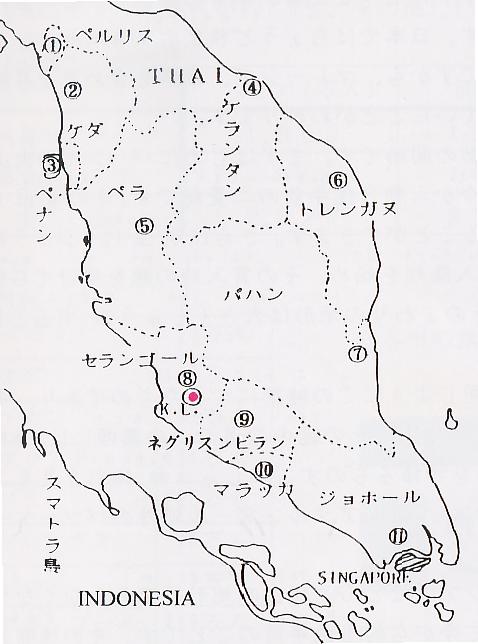 |
| West Malaysia (Peninsular Malaysia) |
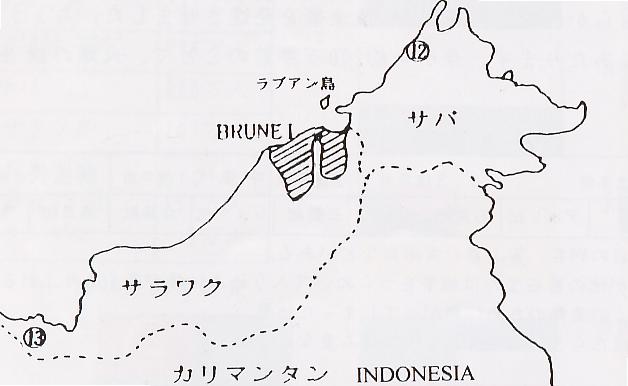 |
| East Malaysia (Northern Borneo) |
| Malaysia is a federal state consisting of 11 states in Peninsular Malaysia
and 2 states in East Malaysia , for a total of 13 states. The former 11
states are , in order from the north , Perlis(200,000 people) , Kedah(1.65
million people) , Penang(1.31 million people) , Kelantan(1.31 million people)
, Pera(2.05 million people) , Terengganu(900,000 people) , Pahang(1.29
million people) , Selangor(4.19 million people) ,Negrisumbrian(860,000
people) , Malacca(640,000 people) , Johor(2.74 million people). The later
2 states are Sabah(2.6 million people) , and Sarawak(2.07 million people
(From the 2000 census) In addition , the capital Kuala Lumper and Labuan
Island are special federal districts under the direct control of the federal
government. The political form is a constitutional monarchy , and the head
of state is decided by mutual election by "Sartan" in nine states
, excluding Penan , Malacca , Sabah , and Sarawak , which don't have "Saltan"
, and the term of office is five years. |
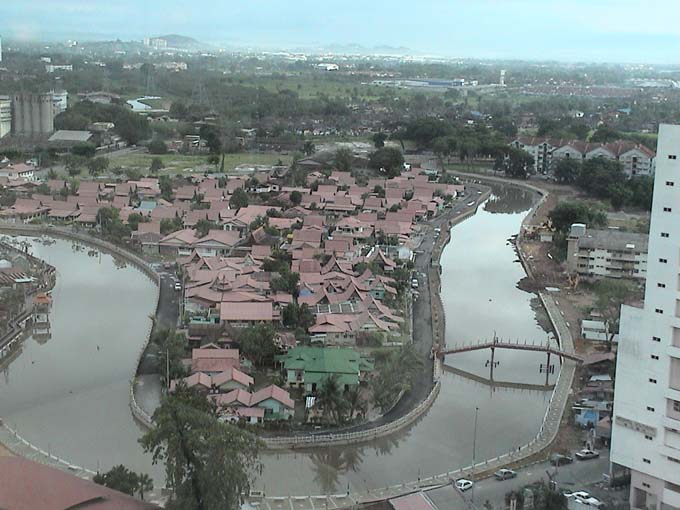 |
| Malacca River and Malay Settlement |
| The King appoints the Prime Minister and approves the law that has passed
the Diet. In addition , based on the advice of the Cabinet , he will excise
administrative authority and lead the 3 armies of land , sea , and air
He is also the head of state religion (Islam). The federal parliament consists of the Senate and the House of Representatives and has a parliamentary cabinet system. The Senate consists of members appointed by the King and members elected by each state parlament. Members of the House of Representatives are elected by the people's direct elections , and constitutionally , the House of Representatives is given greater authorrity. Under the head of state (King) , there is a separation of powers of legislation , judiciary , and administration. |
| Number | State name | State capital |
|---|---|---|
| ① | Perlis | Kangar |
| ② | Kedah | Allostar |
| ③ | Penang | Georgetown |
| ④ | Kelantan | Kota Bharu |
| ⑤ | Pella | Ipoh |
| ⑥ | Terengganu | Quaratrangas |
| ⑦ | Pahang | Kuantan |
| ⑧ | Selangor | Shah Alam |
| ⑨ | Negrisumbiran | Seremban |
| ⑩ | Malacca | Malacca |
| ⑪ | Johor | Johor Bahru |
| ⑫ | Sabah (East Malaysia) | Kota Kinabalu |
| ⑬ | Sarawak (East Malaysia) | Kuching |
| Malaysian's state religion is stipulated as Islam by the Constitution
, but indivisual freedom of religion is also recognized. |
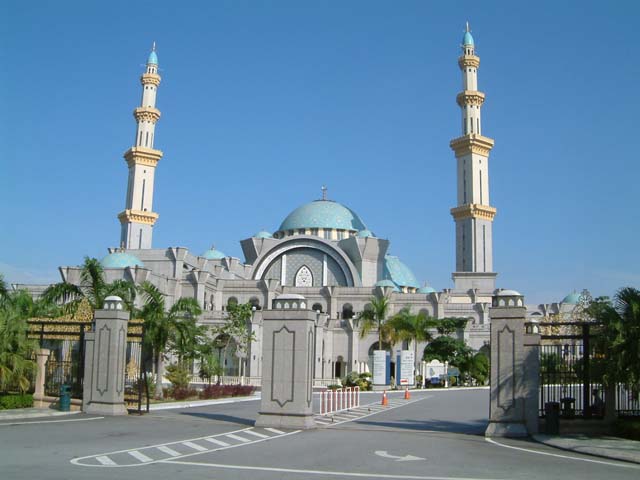 |
| Islamic "mosques" throughout Malaysia |
| Broadly , speaking , in Westen Malaysia , Malays are Muslims , Chinise are Confucian , Taoist , and Buddhist , Indians are Hindus , Europeans and Eurasians are Christians , and the northern minor Thais are Buddhists. On the other hand , in east Malaysia , indigenous peoples are indigenous beliefs. In addition , since Christian erangelism has been active since ancient times , there are a considerable number of Christians as well as Muslims and followers of Chinise religions. The head of Islam , the state religion , is Sartan in each state. In states without Sartans , the chief minister of the state appinted by the state becomes the chief. In Malaysia , which is composed of diverse ethnic groups , many languages such as everyday , Malay , English , Chinise , and Tamil are used. However , from 1967 in West Malaysia and from 1973 in East Malaysia , Malay was stipulated as a "national language , official language". Malay has replaced English , which was previously used as an official document and educational language. Currently , all utility invoices sent to homes , etc. are displayed in Malay. Signs "Let's cherish our language" are set up all over the city of kuala Lumpur , calling on the people to use Malay. However , English is taught from elementary school as a second language. It is also widely used in business. In urban areas such as Kuala Lumpur , English is mostly spoken , but in rural areas , it is only possible to speak Malay. |
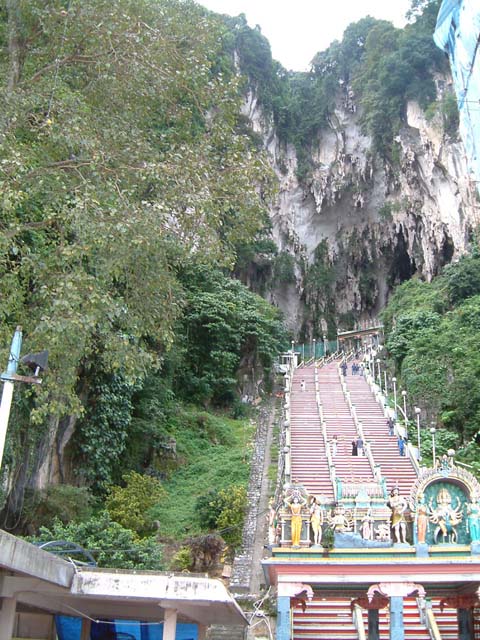 |
| Climb the 272 Steps of the Hindu Sanctuary "Batu Caves" |
| Loacted between the Indean Ocean and the Sauth China Sea , Malaysia has
long been an important transportation route connecting China in the east
and India in the west , and a passage for immigrants. However , unlike
China and India , ancient civilizations were not been born here , and probably
because of the tropical monsoon zone , there aren't many old ruins left.
According to Malay historian Platel , "The oldest stone monument excavated
on the Malaya Peninsula dates from the 5th century AD." |
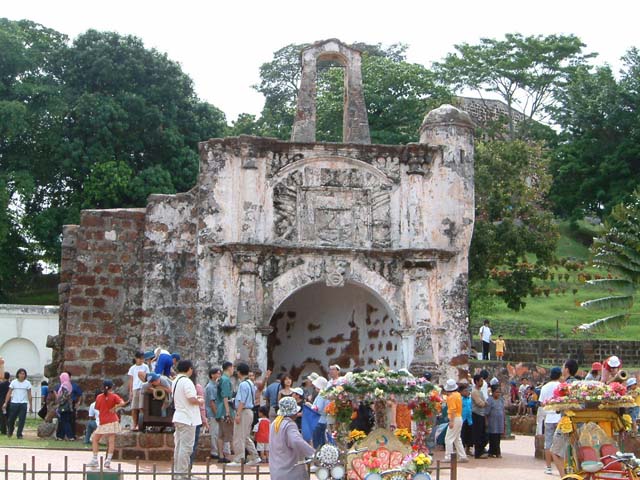 |
| "Fort Santiago" in Malacca , Built by Portugal , Used as a Fortress by the Netherlands and Destroyed by the United Kingdom |
|
<Malacca Kingdom> In the later half of 7th century , the kingdom of Shriwijaya , a marine nation , emerged near Palembang in Sumatra and extended its dominance to Kedah , Kelantan , Terengganu , and Pahang. At the end of the 14th century , Prince Paramesuala of Sumatra was was chased by King Malapahit of Java and moved to Malacca with the Malays to build the Kingdom of Malacca. At that time , the Ayutthaya dynasty of Siam (Thailand) was expanding into Malay Peninsula. Paramesuala summitted to the Ayutthaya dynasty and paid tribute. However , after the Ming ambassador visited the area in the 15 th century , Palamesuala became independent of Siam and became a tribute to the Ming dynasty. Islam is said to have entered the Malay Peninsula in the 13th century. Mugad Iskantal Shah , who succeeded Paramesuala , is said to be the first King to convert to Islam. After his death , Malacca was again attacked by Thai troops. However , King Shri Parameshala Dabershah resisted and defended Malacca's independence. After the victory , the King changed his name to Sartan Musafal Jar. Around this time , Islam became established in Malacca , and the appearance as a nation began to be set. The kingdom , which developed on the basis of international trade , expanded its teritory to various parts of the surrounding area. The range is said to extend to the entire southern part of the Malay Peninsula (currently Peninsular Malaysia) and the central coastal area of Sumatra. <Occupation of Malacca by Portugal> In 1511 , the Portuguese fleet led by Albuquerque occupied Malacca , and King Mahmood Jar moved to Sayun Pinan , upstream of the Johor River , to build the Kingdom of Johor. In the 17th century , the Kingdom cooperated with the Dutch East India Company and in 1641 the East India Company robbed the Portuguese of Malacca. Then , in 1666 , a war broke out with the country of Jambi in Sumatra , exhusting the national power of the Kingdom of Johor. As a result of the Kingdom inviting the Bugistribe of Indonesia's Celebes Island as mercenaries , the Bugis tribe's power gradually went into a state of division. In the 18th century , the Kingdoms of Johor , Bahah , Pella , Kelantan , Terengganu , Kedah and Selangor were separated in the southern part of the Malay Peninsula. <British rule of Malaya> In 1786 , the East India Company used Kedah's internal turmoil to rule Penang Island in Kedah , triggering British rule over the southern part of the Malay Peninsula. Due to the Napoleonic Wars , the Dutch overseas colonies came under British protection , and Malacca was also occupied by the East Indian Company. In 1819 , the british East India Company Stanford Raffle allowed King Johor to colonize Singapore. Subsequently , in 1824 , under the British-Netherlands Treaty , the Netherlands ruled what is now Indonesia , with the exception of Borneo. Britain dominated India , the Malay Peninsula and Singapore. Penang , Malacca , and Singapore , known as the straits settlements , came under the control of the East India Company and were incorporated into the British Crown Colony in 1867. On the other hand , the northern part of the Malay Peninsula was under the control of Siam (Thailand) around this time , and the Malay Kingdom such as Kedah became Siamese territory. However , the kingdom resisted Siamese pressure with the help of the East India Company. The British Coronial Authority , which took over the East India Company , signed an agreement with each Kingdom of Malay , dispatched directors to seize tax collection rights and military rights , and indirectly ruled over Selangor , Pera , Pahang , and Negrisembrian. In 1896 , British colonial officer Swettenham merged these districts into the Federated Malay states. As a result , the Malay Peninsula was divided into the straits settlements , the Federated Malay states , and the non-Federated Malay states. In 1899 , the British - Siamese Border Treaty was signed , and Kedah , Kelantan , and Terenggand became Siamese Dependents. In 1909 , Siam allowed three states and Perlis to be transferred to Great Britain in return for the abolition of extraterritoriality. Each state Sartan refused to join the Federated Malay States. However , in the same year , Johor became a member of British Malay. In the northern part of Borneo , there has been the Kingdom of Brunei since ancient times. In 1841 , the Englishman J.J.Brock obtained Sarawaku , which was under the control of the Kingdom of Burunei , and built the Kingdom of Brooke in 1846 in order to help quell the civil war. Sabah was developed by the Northern Borneo Patent Company on loan from Sartan from 1881, but in 1888 , British government made the Kingdom of Brooke and Sabah a protectorate. <Occupation of Japanese troops , independence , formation of Malaysian Federation> In 1941 , the Pacific War began , and in January 1942 , the Japanese troops occupied the entire Malaya except Singapore , and in February the following year , they occupied Singapore. After the defeat of Japan in 1945 , Britain proposed the "Malayan Union Plan" to integrate the nine Malay states excluding Singapore with Penang and Malacca to give Malaya equal rights , Malays , who were given preferential treatment during the Japanese occupation , opposed the fear of losing their vested interests and formed a certain Malay national organization. In 1948 , Britain amended the Malayan Unit proposal. He proposed the Federation of Malaya , which strengthened the authority of Sartan in each state and made it difficult for nine-Malay residents to obtain citizenship. Here , the "Federation of Malaya" was formed. The Chinese , who were dissatisfied with this , once fought a guerrilla warfare. However , Britain responded by giving Chinese residents the opportunity to participate in politics. In 1949 , "馬華公会" was formed as a political party of Chinise inhabitants , and the Unit Malays National Organization and "馬華公会" signed a coolition agreement. In 1954 , the Malaya-Indian Congress , an Indian political party , also participated , and the Union Malay National Organization , "馬華公会" , and the Malaya-Indian Congress formed a federation party. In 1955 , the federation won the first general election in July. On August , 31 , 1957 , the Federation of Malaya became completely independent and Abdal Rahman became Prime Minister. Sabah and Sarawak , which were Britidh protectors became crown colonies and were gradually provided with autonomy. Prime Minister Rahaman called for the formation of the Federation of Malaya , Singapore , Sarawak , Sabah and Brunei. On September , 16 , 1963 , the Malaysian Federation , excluding Brunei , was established. However , the conflict between Singapore and the federal government intensified over financial problems , and on August 9, 1965 , Singapore withdrew from the federation.on. The people's Action Party , led by Singapore's Prime Minister Leak Wan Yu , who joined the Malayan Federation as a state in 1963 , existed as an opposition party in Malaysia. However , after the devision of Singapore , the registration as a political party was canceled and it became the Democratic Action Party in 1966. The party is opposed to the Bumipotera policy , advocating all-race equality in Malaysia , with the slogan "Malaysia of Malaysians" |
| Since independence , Malaysia has been on the three pillars of (1) islam
as national religion (2) Malay as national language , and (3) giving priority
to indigenous peoples and Malays , that is , the people called Bumiputera
(Children of the land) . We have been building a country centered on Malay
people. This is due to the fact that Bumiputera's socio-economic status
is generally lower than that of Chinese and Indian residents. |
 |
| The Word "WAWASAN 2020 (vision 2020)" Stands Out |
| In 1969 , on May 13 , immediately after the 3rd general election , a clash
between Chinese and Malay residents occurred in Kuala Lumpur , killing
178 people. In the wake of this racial riot , Malaysian announced Lucnegala
in the name of the King in August 1970. It has the following five contents.
(1) Faith in God , (2) Loiality to the king and nation , (3) Observance
of the Constitution , (4) Governance by law , (5) Sensible behaivior and
morality. In March 1971, the Diet restricted freedom of speech and made
the following consitutional amendments. (1) Special status of Malays (Priority
of Malays such as recruitment to civil servants , scholarships , granting
of specific occupation licenses , etc. as stipilated in the constitution)
, (2) Malay as a national language , (3) It was forbidden to discuss "status
and citizenshop of Sartan" in public . This once again recognizes
the Malay's priority in politics. On the economic front , a long term plan for 20 years from 1971 was launched as a new economic policy. After seeing its end in 1990 , it continued to promote the Second Long-Term Coomprehensive Plan. Among them , it aimed to enter a developed country in 2020 (Vision 2020). The breakthrough is remarkable. Bumiptera policy was taken over by Andal Rahman , Abdul Razak and Hussein Onn. It was further promoted by Mahathir , who became Prime Minister in 1981. Mahathir said that Malays must be at the core of Malaysia's modernization , with the aim of improving the status of Malays. He worked to purify politics and bureaucracy , and set up a "Look East Policy". It was an appeal that the education and training of Malay people should be promoted based on the moderation of Japanese and South Korea. It means that they must be capable of retaining the privileges currently guaranteed by law , rather than acception them. In order to change the atitude that had been devoted to Europe and the United states (especially the United Kingdom) until then , he called for a boycott of British products. It can be said that the alternative policy is "Look East". Foreign companies operating in Malaysia are also subjected to the Bumiputera policy regulation that when hiring employees , both managers and non managers must match tne population ratio by race. With these policies , the number of Malay Univercity students and civil servants has skyrocketed , and rural development has made great strides. However , on the other hand , the dissatisfaction of the discriminated Chinise and Indian residents is not small. Ethnic harmony remains greatest political challenge for Malaysia , a multi-ethnic country. |
| Transport in Malaysia started and developed as a means of transporting
goods. It was aimed at exporting "rubber and tin" , which was
the center of economic activity during the colonial era. Therefore , the
history of road maintenance connecting cities is new and is still in progress. |
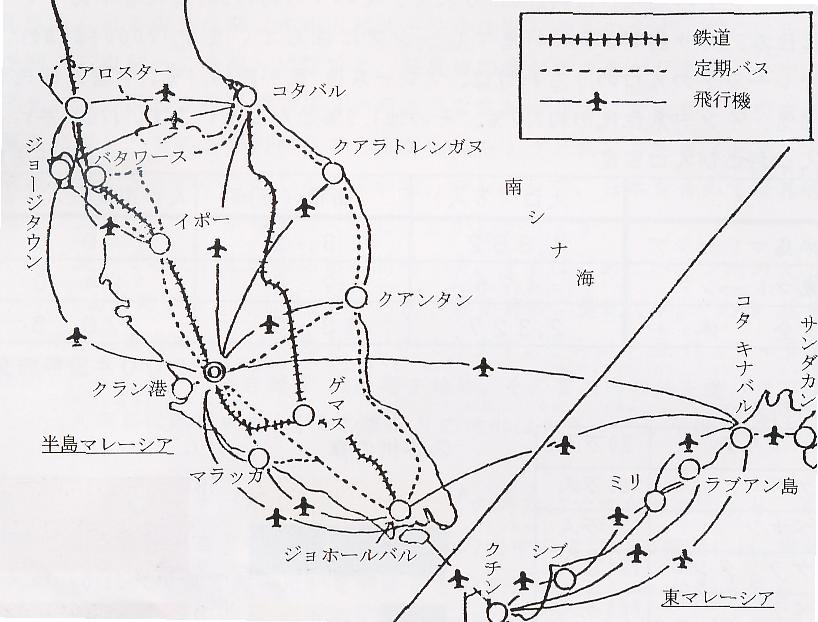 |
| Transportation Network(Railroad、Regular bus、Airplane) |
|
<Railroad> 1885 ・・・ the "Tin Railway" was built between Taiping and Portweld in Perak. After that , it was extended between Seremban and Port Dickson. 1909 ・・・ The section between Batowers and Johor Bahru , which runs through the Malay Peninsula , was completed. By 1924 , it had become a "transcontinental railroad". Currently , the following two railways are available on Peninsula Malaysia. The "Transcontinental Railroad" that runs from Singapore throough the western part of the peninsula , and the rail road that runs from Gemas through the center part of the peninsula to Tampat (Thailand). In East Malaysia , there is the Sabah State Railway between Tanjongal and Tenom in Sabah. 1996 ・・・ The STARTLAT (elerated railway) that runs north and south in the eastern part of Kuala Lumpur has opened. 1997 ・・・ STARLRT , which runs between Centur Timer and Sri Petalin has opened. 1999 ・・・ The PUTRALRT , which connects the city center with the east and west suburbs , has opened. 2001 ・・・ KL Central Station has opened. 2002 ・・・ The KLIA (Kuala Lumpur International Airport) Express , which connects KL Central Station and KLIA directly in 28 minutes , was operated. 2003 ・・・ The KL Monorail , which connects KL Central Station and Titiwansa Station for about 8.6 km , was operated. |
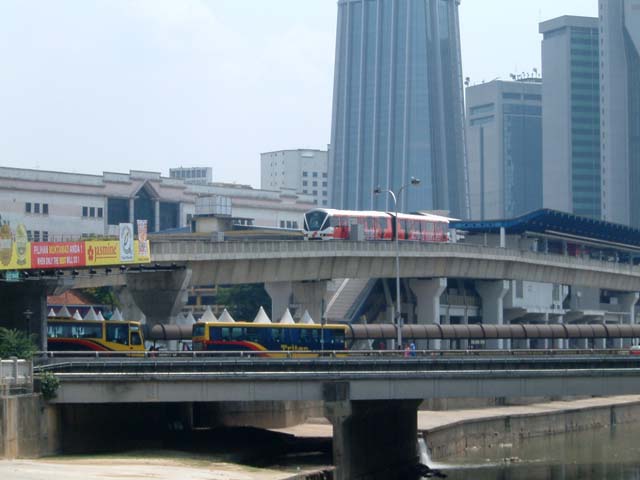 |
| Trains and Buses That Cross Overpasses (in KL city) |
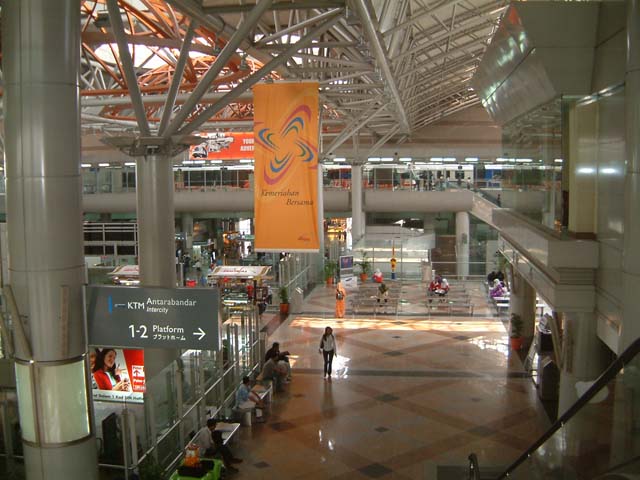 |
| Central Station like an Airport |
|
<Road> National highway No.1 ・・・ It runs through the Malay Peninsula from the north to the south end of the west coast of the peninsula. National highway No.2 ・・・ It extends from Klang Port through Kuala Lumpur to Kuantan. National highway No.3 ・・・ Along the west coast , it leads from Kota Bharu to Johor. North-South Expressway ・・・ It connected Penang and Singapore within eight hours and was fully opened in early 1994. In East Malaysia , maintenance is being promoted mainly on road pavement. |
 |
| Expressway Toll House |
| <Aviation> Currently , there are a total of 23 scheduled takeoff and landing airports , 12 in Peninsular Maaysia and 11 in East Malaysia. Domestic flights connect major cities around Kuala Lumpur , there are almost daily flights between other cities. 1972 ・・・ MSA(Malaysia Singapore Airline) has separated into Malaysia Airkines and Singapore Airlines and started operation. 1990 ・・・ The total number of air passengers in Malaysia will increase 2.5 times from 7.2 million in 1980 to 18.15 million. 1998 ・・・ Kuala Lumpur International Airport (KLIA) , which replaces Subang International Airport , has opened in Spang Selangor. 2002 ・・・ All domestic flights have been transferred to Kuala Lumpur International Airport (KLIA). 2020 ・・・ Initially , there was a plan to expand KLIA , which was opened as a facility that can be used by 25 million people a year , to a facility that can be used by 60 million people a year by 2020. |
 |
| Kuala Lumpur International Airport (KLIA) |
 |
| You Travel by Train to the Boarding Gate (KLIA) |
| <Harbor> Penang , which once prospered as an east-west relay trading port , was replaced by Singapore. The new three ports of Butterworth , Port Klang , and Johor are being developed. In Malaysia , shipping plays a major role geographically , and more than 90% of transportation depends on shipping. |
| There are many kinds of animals in Malaysia. Here are some of them. |
| Malayan Tiger It is a large carnivore with a body length of about 2m and belong to the family Felidae. It originated in Malaysia , Java and Sumatra and spread throughout Asia , northern China , Siberia and Western Iran. |
 |
| Malayan Tiger |
| Malayan SunBear It is a large carnivore , relatively small among bear species , and is about 1.5m long. It is believed that it originated in eastern India and came to Malaysia. It usually eats fruits , vegetables , termites and honey. It has sharp daws and occasionally attacks small animals. |
 |
| Malayan SunBear |
| Short-Tailed Mole It is a rare small carnivore firs found in a tea plantation in Cameron Highlands in Malaysia in 1937 |
| Malayan Tapir It is a herbivore with white and black body colors and a white belly , and is said to be a "dream-eating animal". It is nocturnal and sleeps during the day. After dark , it looks for food such as aquatic plants , fruits , and leaves , and eat dexterously with a long , elongated mouth. |
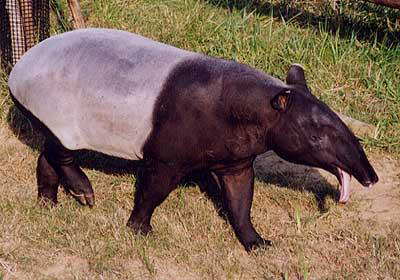 |
| Malayan Tapir |
| Malayan Colugo The outer shape resembles a flying squirrels , the mouth is long , and it is nocturnal. At night , it glides from tree to tree and eats fruits , buds , flowers and leaves. In particular , it often prefers to eat coconut palms and harms the palm gardens. |
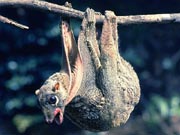 |
| Malayan Colugo |
| Slow Loris Also , known as a "clown monkey or noroma monkey" , it is nocturnal , lives on trees , and never descends to the ground. The movements are extreamely slow , step by step carefully , walking the best and eating insects , fruits , leaves and more. |
 |
| Slow Loris |
| Mouse-Deer It is a small animal with a body length of 40 to 50cm and a body weight of 2kg. The face is very similar to a mouse , and the figure below the neck is a miniature version of a deer. However , its tail is very short. It is nocturnal and likes sprouts , new leaves and grasses of trees , especially the fallen fruits. Although , it is small , it protects itself from tigers and crocodiles with its wisdom and quickness. It often appears in folk tales and has become a symbol of the National Zoo. |
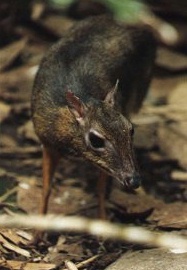 |
| Mouse-Deer |
| 60% of the total in Peninsular Malaysia and 70% of the total in East Malaysia
are rainforest jungles. In tropical Malaysia , you can enjoy beautiful
flowers all year round. In the tenperute Japan , you can see rare colorful
flowers and strangely shaped trees that you have never seen. In the jungle
, there are many ever green broad-leaved trees and large trees of gymnos
permssuch as wood ferns , cycads , and palm palms. Hyophorbe lagenicus
is also common in towns and residential areas. There are few plants native
to Malaysia. |
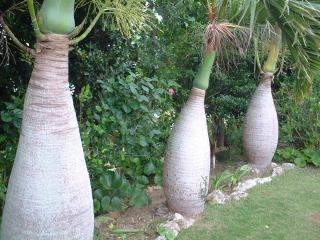 |
| Tokkuriyashi (Hyophorbe Lagenicus) |
| There are 130 kinds of fruits grown in Malaysia including wild ones. About
one-third of them are native to Malaysia. Many Malaysian fruits contain
a lot of vitamin C. |
| Fruits native to Malaysia | Durian , Mangosteen , Rambutan , Banana , Pomero , Baccaurea , Cermai , Brinbin Assam , Mango , etc. |
| Fruits imported to Malaysia | Papaya , Pineapple , Guava , Chiku , Durian branda , Indian mango , Water apple , Jackfruit , Pomegranate, Watermelon , etc. |
| Fruits that can be eaten all year round | Papaya , Banana , Pineapple , Guava , Chiku , Watermelon , Lemon , Orange , etc. |
| Fruits only twice a year | Durian , Ranbutan , Puller Sun , Mangosteen , Duk , Langsat , Baccaurea
, Jackfruit , Champbuck , etc. There are two seasons , June-September and December-February. The former has more quantity and type than the latter. |
| Below are some typical Malaysian fruits. |
| Durian It is an evergreen tree of the Bomhax family native to Malaysia , and can reach a height of 40m. It is called the "King of Fruits" and it is said to be "the tast of heaven , the smell of hell". It is about the size of a child's head , and its surface is covered with rough , pointed thorns of 1 to 3cm. The fruit is divided into 4 to 5 chambers and contains several seeds wrapped in cream-colored , yellow-colored fruits of about 5×2cm. The flesh is a little sticky and soft , with a strong aroma and sweetness, and is nutritious. |
 |
| Durian |
| Mangosteen It is an evergreen tree of the family Otogirisowa native to Malaysia , which takes 15 years to bear fruit and is one of the slowest growing trees. It is called the "Queen of fruits". The fruit produced by asexual reproduction is shaped like a small red-purple oyster. At the tip of the fruit , there are 5 to 8 woody calyxes. The number matches the number of white berries inside. When the thick and hard skin is opened , pure white flesh appears , and it has a moist , sour and sweet taste. |
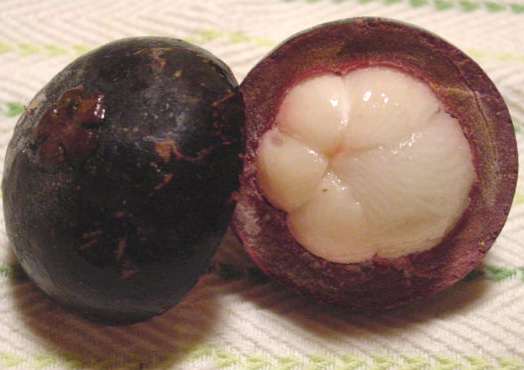 . . |
| Mangosteen |
| Mango It is a family of lanquer tree native to Southeast Asia and is called "fruit princess". As a garden tree , it is planted in most homes. The color , shape and size of the fruits are varied , and the time of flowers and fruits is not constant. The taste is also greatly affected by the climate and soil quality. When ripe , the surface turns green , yellow , orange , and the flesh is moist , sweet and sour , with a slight odor. In the center of the flesh , there is a large , hard seed wrapped in fiber. There is a wide variety of products such as "Indian" , "apple" , "coconut" , "papaya" , "Thailand" and "Philippines". |
 |
| Mango |
| Rambutan Native to Malaysia , the name comes from the Malay word "Rumbut" (hair) . The surface of the fruit is covered with soft red and yellow hair-like protusions. The pericarp is thin , smooth , and wraps around sweet , moist white translucent fruits. Among the fruits of Malaysia , it is the most popular and well-eaten. In the twice-yearly season , chestnut-like fruits are sprouting from the branches. |
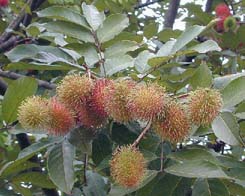 |
| Rambutan |
| Starfruit It is a carambola family native to Southeast Asia , and it was named "star fruit" because it has a star shape when the fruit is slicesd into round slices. Flowers and fruits can be seen all year round , with a smooth surface and a waxy luster. The fruit has a lot of water , but it is not very sweet. |
 |
| Starfruit |
| Papaya It is a caricaceae native to South America and is widely cultivated in the tropics. It has a upright trunk with a hollow center. It grows fast and bears fruit in half a year to a year. Fruits vary in shape , size and taste. The pericarp is thin and smooth , and the flesh is juicy , delicious and nutritious. |
 |
| Papaya |
| Jackfruit It is a Morus alba family native to India , and is the largest of all fruits , with a length of 30 to 90 cm , a width of 25 to 50 cm , and a weight of 20 kg. The pericarp is yellowish and covered with short , blunt , thick thorns. Small flesh of 5 to 6 is lined up in a fruit , and it is a very sweet fruit suitable for a strong sweet smell. There are two types , "Nanka" and "Chumpu Duck". |
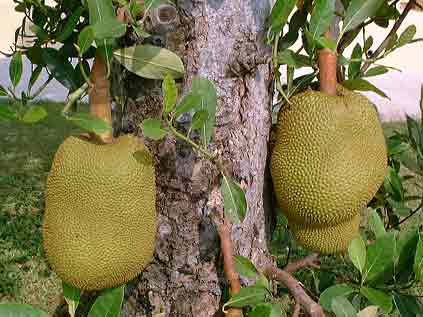 |
| Jackfruit |
| Pineapple It is a Bromeliaceae native to South America and is now widely cultivated in Malaysia , Celebes , West indies , Hawaii , Florida , Taiwan , etc. A sword-shaped leaf is attached on a short trunk with a height of several tens of centimeters.The leaves are hard , fleshy , with spiny protrusions on both sides. Many flowers gather and form a pine cone. After the flowers bloom , the pine cones grow larger and bear fruit. The flesh is very moist and very sweet. |
 |
| Pineapple |
| Dragonfruit It is a cactaceae native to Central America and is called Vitaya in Europe and the United States. The flowers bloom like a queen of the night in the middde of the night , and the fruits are about 15 cm in diameter. It is resistant to typhoons and pests , has no habit , and has a refreshing sweetness. |
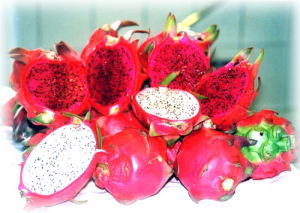 |
| Dragonfruit |
| Under the long-term British colonial rule , the production value of "tin"
and "natural rubber" , which have become Malaysia's leading industries
is declining. Instead , the export value of palm oil and crude oil has
increased in recent years. In addition , the machinery industry and heavy chemical industry have also grown due to the expansion of Japan and other countries into Malaysia. In paticular , the machinery industry has come to rank first in export items. Furthermore , recently , they are also focusing on fostering the information industry. |
| ①Natiral rubber Rubber gardens account for 30% of the total cultivated land area in Malaysia. Rubber gardens are concententrated on the west coast of Peninsular Malaysia. In the 1990s , rubber replaced palm palms as the top spot in cultivated land area. |
 |
| They Make a Cut in the Rubber Tree and Collect the Sap. |
| Year | Cultivation area (Thousand ha) | Production (Thousand tons) |
|---|---|---|
| 1985 | 1956 | 1472 |
| 1990 | 1837 | 1291 |
| 1993 | 1763 | 1074 |
| 1995 | 1679 | 1089 |
| 1999 | 1464 | 859 |
| 2001 | 1265 | 801 |
| ②Palm oil Palm oil has grown rapidly to become Malaysua's most important export item after natural rubber since the mid-1970s due to the government's trade policy. Due to the advantage of requiring less labor then running a rubber garden , a large plantation was converted from a rubber garden to a palm garden. Palm oil is a vegetable oil and is a raw material for the food industry , which is in high demand. Along with soybeans , it is the most powerful primary food product. |
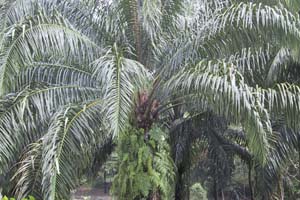 |
| Palm palm(Palm oil can be obtained) |
| ③Rice Malaysia's staple food is rice. Rice cultivation is very small and has been neglected for a long time without the introduction of new technics. In recent years , the development of irrigation facilities and the intoduction of double cropping have been promoted. The self-sufficiency rate of rice is 70% or less , and it is imported from Thailand , Pakistan , etc. |
| ④Wood Malaysia is a rich source of South Sea lumber , and exports of "logs and lumber" are carried out. Most of the log exports are from East Malaysia and most of them are to Japan. On the other hand , 16 types of logs such as Lauan are banned from the export of logs from Peninsular Malaysia. Therefore , in Peninsular Malaysia , the wood processing industry has developed and the export of woodwork products is flourishing. |
| ⑤Fishing industry In recent years , fishing boats and fishing gear have been enlarged and modernized from the coast fishing center to the offshore fishing center. Along with that , the catch is increasing. In addition , shelfish and shrimp are being cultivated widely. |
| ⑥Others ■Papper ・・・ Malaysia is the world's fourth largest producer of papper and produced 17% of the world's production in 1999. Most of Malaysian papper is produced in Serawaku and Johor. ■Coconut ・・・ Coconut has a longer history of cultivation in Mlaysia than rubber and palm oil , and has been cultivated mainly in small farms. However , the planted area gradually decreased to about 280,000ha in 1999. ■Cocoa ・・・ Cocoa is one of the most important agricultural products after palm oil and natural rubber. It was first introduced in Sabah in the late 1970s. Even now , it is actively cultivated in Sabah and occupies falf of the cultivated area in the whole country. The production volume in 1999 was 92,000 tons. ■Others ・・・ Crops such as coffee , pineapple , cacao , tea , spices , tapioca , vegetables , tobaco , and sugar cane are cultivated. Fruits are cultivated mainly in Johor , and durian , banana , guava , star fruit , etc. are exported. |
| ①Electricity industry The production of televisions for export , video , air conditioners , etc. , the semiconductor industry , and the electoric parts industry are the three pillars of the electrical industry. The production value of the entire electric indusrtry continues to grow every year , partly due to the expansion of overseas companies into Malaysia. |
 |
| Japanese Companies Operating in Malaysia |
| ②Automotive industry Following the domestic car Proton Saga , domestic cars have been produced and sold one after another. In Malaysia , they are also focusing on the parts industry such as automobils and motercycles , and now most parts can be procured locally. |
| ①Tin Tin mines are concentrated in Selangor and Perak , which account for 90% of total output. Tin production has declined since the early 1960s, surrendering the number one position to Brazil. Due to the release of tin from Brazil , China , etc. , excess tin has been sapplied , prices fave fallen , and Malaysian microminers have been hit hard. |
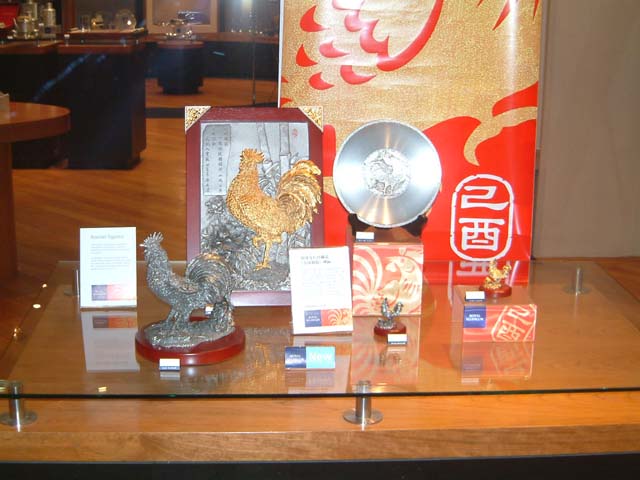 |
| At a Tin Product Speciality Store (Inside Midvalley Megamall) |
| ②Petroleum and liquefid natural gas(L.N.G.) The oil-producing areas are the east coast of Peninsular Malaysia and East Malaysia. Malaysia's oil mining is new and many oil fields were discovered in the 1970s. The daily production was 300,000 barrels in the 1980s and 620,000 barrels in 1990 , and the production volume increased significantly. Exports are also active , and it is the second largest export product. In Sarawak , East Malaysia , liquefied natural gas was developed using natural gas , and export to Japan beban in 1983. 54 trillion cubic feet of natural gas reserves have been confirmed. |
|
| Malaysian children go to Kindergarten for a year or two. The education
of the people , which is similar to compulsory education in Japan , is
6 years in elementary school and 3 years in junior high school. Unlike
compun lsory education in Japan , this national education doesn't regally
stipulate the obligation of parents to enroll their chilren. Elementary
school education begins at the age of six. This national education is provided free of charge to all Malaysian children. However , each child and student is supposed to pay the library usage fee , stationary set price , and sports equipment price once a year. Malaysia's national education is implemented with the following four basic policies.
In paticular , Malaysia is a multi - ethnic country such as Malay , Chinese , and Indian , so the third basic policy is the most important national education issue. As a policy of educational administration , the establishment of the educational institutions that can give priority to the language and culture of each ethnic group is permitted. In addition to the national schools established by the Malay government , quasi-national schools of Chinese and Indian descent have been established.
In this way , these educational institutions are obliged to take Malay , which is the national language , as well as being able to teach each ethnic language. Malaysian school education , which was changed from English education to Malay language education in 1969 , began teaching Mathematics , Arithmetics , and science in English from the first grade of all elementary and junior high schools from 2003. |
| Elementary school education is from 1st grade to 6th grade. Some schools
offer two-part classes in the morning and afternoon. Subjects studied in elementary school include Malay , English , math , Arithmetic , drawing and morals , Alamdan Manusia (a subject to learn about Malaysian creatures) , and Agama (religious education for Moslem). Children other than Moslem don't take Agama , but intead are required to take moral education. In addition to studying these subjects , elementary school students are required to attend club meetings once every two weeks. The types of clubs vary from school to school , but include English clubs , Malay language clubs , computer clubs , badominton clubs , swimming clubs , table tennis clubs , soccer clubs , art clubs , science clubs , and arithmetic clubs. In addition to these club meetings , weekly sports practice is compalsory. One unit time is 30 minutes , which is 15 minutes shorter than Japan. |
| 07:35-08:05 | 08:05-08:35 | 08:35-09:05 | 09:05-09:35 | 09:35-10:05 | 10:05-10:25 | 10:25-10:55 | 10:55-11:25 | 11:25-11:55 | 11:55-12:25 | 12:25-13:05 | |
|---|---|---|---|---|---|---|---|---|---|---|---|
| Mon | All school meeting | Arithmetic | Morality・Religion | Malay language | Malay language | Break time | English | Music | Nature・Humanity | Nature・Humanity | Arithmetic |
| Tue | Physical education | Nature・Humanity | Morality・Religion | Morality・Religion | English | Break time | English | Arithmetic | Malay language | Malay language | Arithmetic |
| Wed | Extracurricular activities | Extracurricular activities | English | Molality・Religion | English | Break time | English | Arithmetic | Malay language | Malay language | Arithmetic |
| Thu | English | English | Nature・Humanity | Morality・Religion | Nature・Humanity | Break time | Malay language | Malay alnguage | Arithmetic | Art | Art |
| Fri | Malay language | Malay language | Physical education | Morality・Religion | English | Break time | Arithmetic | Nature・Humanity | Nature・Humanity |
| In the 6th grade of elementary school , all children must take a unifield
government test called UPSR (elementary school test). This test checks
the academic ability of each 6th grader in elementary school. Malay , English
and math scholastic ability are checked. However , since this test is not
aimed at advancing to higher education , they can automatically advance
to Form 1 after that. In Japan , the new semester begins in Aprril , but
in Malaysia , it starts on January 2nd and ends on November 30th. The first semester is from January to May , and the second semester is from mid-June to November. There is a two-week break in March , a three-week break in June , and a one-month long term left at the end of the year in December. |
| In jinior high school education , it is common for schools to adopt a
two-part system of morning classes and afternoon classes. Morning classes
are held from 7:25 am to 1:10 pm. This schedule is from Monday to Thursday
, and classes are held on a special scedule on Friday. Friday afternoon classes start at 2:20 pm and end at 6:40 pm. This is because many mosques go to the mosque on Fridays to worship and avoid the time of worship. There are about 30 residental schools nationwide , which are boarding schoools for middle and high school integrated education. In forms 1 , 2 and 3 junior high schools , students study Malat , English , geography , history , technical homes , morals , Agama Islam (religious education for Moslem students) , science , mathematics , heaiyh , physical education , art , etc. It incorporates 8 or 9 credit hours of learning per day , 1 credit time is 40 or 45 minutes. Students in Forms 3 are required to take an unifiied government test called PMR (Junior High School Examination). This PMR is carried out nationwide from September to October every year. All junior high school students must also participate in special activiries. Clubs and committees are held once every two weeks , and sports practice is compulsory once a week. Many junior high schools hold sports festivals around February or March every year. |
| Month | Event ・ Long vacation |
|---|---|
| January | New semester starts (2nd) |
| February | 2 weeks long vacation |
| March | Term-end exam |
| May | All-school team compettition game , Inter-school quiz competition , History test , Computer forum |
| June | Computer forum , 3 weeks long vacation , Adlescent form , Inter-school art competition , Term-end exam |
| July | Inter-school history quiz competition , Inter-school theater competition , Open class day , Parent's association , School speach contest |
| October | Inter-school art competition , Nature conservation day competition , End of year test , PMR Government Uniform Test |
| November | Year end date (22nd) |
| December | 1 month long vacation |
| High schools on Form 4 and 5 are divided into cultural courses and science
and technology courses. Students in curutural courses will study Malay , English , History , Geography , Echnical Home , English literature , Fine Arts , Ethics , Mathematics and Science. Students in science and technology courses will study English , Malay , History , Ethics , Mathematics , Advanced Mathematics , Physics , Science , Biology , and Accounting. Form5 students take the government SPM test at the end of the school year in early October. Students who perform well on this test are guaranteed admission to Form6. Upon completing Form5 , many students go on to private colleges (university preparatory courses) in order to obtain qualantications that match their career path , in order to enter foerign universities. The major destinations for study abroad are the United Kingdom , the United States and Australia. In 1981 , Former Prime Minister Mahathir wanted to incorporate the Japanese people's work ethics , willngness to work management ability , high morality as a national character , and willngness to educate and learn into Malaysia in the future nation-building. He announced the "Look East Policy" and encourged students to study in Japan. In 1999 , a cumulative total of over 5700 people studied in Japan. |
| Year | Undergraduate student | Technical college student | Japanese teacher | Industrial technology training | Excutive management practice | Senior government official | Total |
|---|---|---|---|---|---|---|---|
| 1982 | 135 | 11 | 146 | ||||
| 1983 | 418 | 9 | 427 | ||||
| 1984 | 39 | 24 | 248 | 10 | 321 | ||
| 1985 | 45 | 28 | 236 | 16 | 325 | ||
| 1986 | 64 | 30 | 229 | 17 | 340 | ||
| 1987 | 79 | 30 | 221 | 14 | 344 | ||
| 1988 | 81 | 30 | 202 | 9 | 322 | ||
| 1989 | 84 | 30 | 176 | 7 | 297 | ||
| 1990 | 83 | 29 | 10 | 152 | 8 | 282 | |
| 1991 | 90 | 30 | 10 | 119 | 5 | 254 | |
| 1992 | 104 | 45 | 12 | 146 | 5 | 312 | |
| 1993 | 113 | 58 | 15 | 119 | 10 | 13 | 328 |
| 1994 | 136 | 72 | 20 | 107 | 30 | 14 | 379 |
| 1995 | 123 | 69 | 17 | 78 | 28 | 315 | |
| 1996 | 128 | 71 | 11 | 80 | 35 | 325 | |
| 1997 | 145 | 81 | 10 | 60 | 42 | 14 | 352 |
| 1998 | 147 | 93 | 6 | 69 | 20 | 335 | |
| 1999 | 141 | 83 | - | 47 | 42 | 313 | |
| 合計 | 1,602 | 803 | 111 | 2,842 | 318 | 41 | 5,717 |
| As of 2003 , Malaysia has nine national universities and one international
Islamic university , for a total of ten university. There are also nine
private universities. The total number of students 222704 , equivalent to 11% of the same generation population. |
| University name | Short name | Year of establishment | Number of students (2000) | Location |
|---|---|---|---|---|
| ① University Malaya | UM | 1962 | 21,635 | Kuala Lumpur |
| ② National University | UKM | 1970 | 24,938 | Selangor |
| ③ Putra University | UPM | 1971 | 30,732 | Selangor |
| ④ University of Technology Malaysia | UTM | 1972 | 26,977 | Johor |
| ⑤ Northern University | UUM | 1984 | 13,940 | Kedah |
| ⑥ International Islamic University | UIAM | 1983 | 13,263 | Selangor |
| ⑦ Mara University of Technology | UiTM | 1956 | 62,216 | Selangor |
| ⑧ Science University | USM | 1969 | 20,459 | Penang |
| ⑨ University of Sarawak Malaysia | UNIMAS | 1992 | 2,558 | Sarawak |
| ⑩ University of Sabah Malaysia | UMS | 1994 | 4,154 | Sabah |
| University name | Faculty ( Department ) |
|---|---|
| ① University Malaya | Humanities , Social sciences , Economics , Government , Law , Pedagogy , Destistry , Medicine , Islamic Law , Islamic Theology , History , Ethnology |
| ② National University | Chemistry , Pedagogy , Electrical/Electronic Engineering , Housing/Architecture , Humanities , Materials/Resources , Mathematics/Information , Medicine ,pharmacy , Physics , Sociology |
| ③ Putra University | Agriculture , Pedagogy , Engineering , Fisheries/Oceanology , Food chemistry , Forestry and Environmental Chemistry , Veterinary and Animal Husbandry (Faculty of Ecomnomics in Teren) |
| ④ University of Technology Malaysia | Electorical Engineering , Mechanical Engineering , Civil Engineering , Architecture , Surveying |
| ⑤ Northern University | Economics , Accounting , Economic Administration |
| ⑥ International Islamic University | Economics , Jurisprudence |
| ⑦ Mara University of Technology | Pedagogy , Physics and Chemistry , Science , Electronic Engineering , Architecture , Physical Engineering , Information Engineering , Mechanical Engineering , Management Engineering , Electronic Engineering , Civil Engineering , Forest Science |
| ⑧ Science University | Biology , Chemistry , Pedagogy , Electrical/Electtonic Engineering , Humanities Housing/Architecture , Geography , Materials/Resources , Medicine , Pharmacy , Mathematics/Computer , Physics , Social Sciences |
| ⑨ University of Sarawak Malaysia | Electrical Electrinics , social sciences , International information , Arts , Agriculture , Computer Engineering , Linguistics |
| ⑩ University of Sabah Malaysia | Linguistics , Pedagogy , Pharmacy , Library Science |
| University name | Short name | Year of establishment | Location |
|---|---|---|---|
| (1) Intertational Dental College | I.M.U. | 1993 | Kualla Lumpur |
| (2) Tenaga National University of Electrical Engineering | U.N.I.T.E.N | 1997 | Selangor |
| (3) Petronas University of Science and Technology | U.T.P. | 1997 | Perak |
| (4) Multimedia University | M.M.U. | 1997 | Cyberjaya |
| (5) Tuh Abdul Razak University | U.N.I.T.A.R. | 1998 | Selangor |
| (6) Monche University Malaysia | M.U.M. | 1998 | Selangor |
| (7) Curtin University of Science and Technology | C.U.T. | 1998 | Sarawak |
| (8) University of Notting hum Malaysia University name | U.N.I.M. | 2000 | Kuala Lumpur |
| (9) Rimkok Wing IT Design University | L.U.C.C.T. | 2003 | Cyberjaya |
| After Malaysia's independence , Japan not only provided financial assistance
to Malaysia's development projects , but also accepted trainees under the
"Look East Policy". Furthermore , technical cooperation has been
provided , including the acceptance of Malaysians under the Youth Invitation
Program. By 2002 , about 6600 students and professionals had been dispatched
to Japan for study or training under the "Look East Policy" ,
which began in 1982. After returning to Malaysia , they are active in various
fields as leaders of govenment agencies and companies. |
 |
| Condo Entrance Guard House(Checking security) |
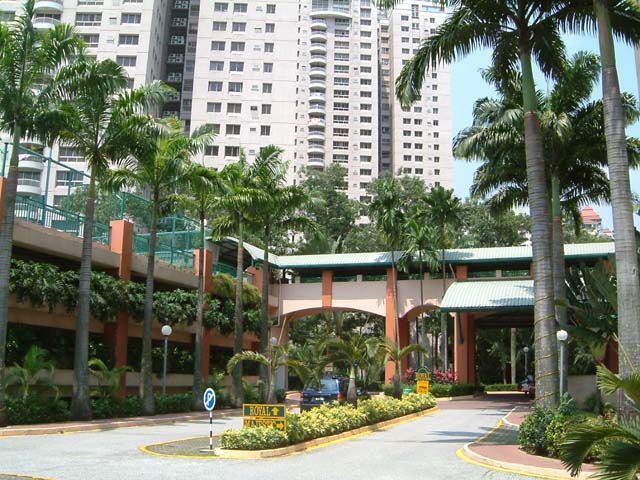 |
| Condominium(High rise apartment) |
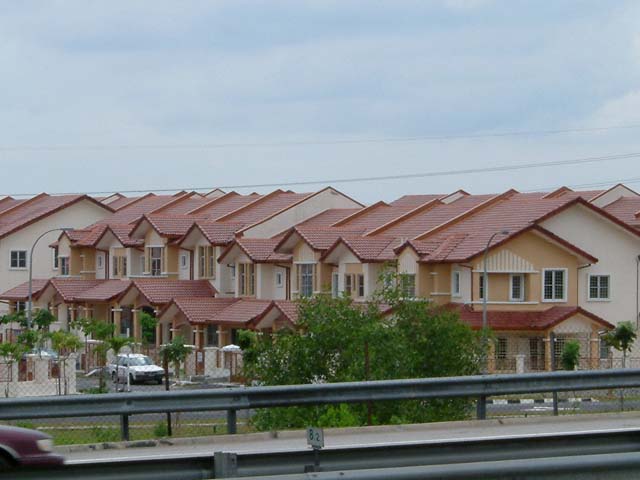 |
| Link House |
| Since 1987 , investment from Japan has increased significantly in response
to Malaysia's policy of actively attracting foreign. In 1967 , there were less than 100 Japanese living in Kuala Lumpur. There were no condominiums , and people lived in link houses. There were no Japanese restaurants , and the area around Shah Alam was covered with extensive rubber plantations. Today , many Japanese restaurants are oprerating , condominiums are lined up here and there , and the Shah Alam area has transformed into a large international area. Many Japanese companies have moved into this area and are actively engaged in production activities. In 2002 , there were 1368 Japanese companies operating in Malaysia , and 11237 Japanese residents. It speaks of the closeness between Malaysia and Japan. |
| Year | Number of Japanese companies | Number of Japanese residents |
|---|---|---|
| 1986 | 477 | 4,096 |
| 1992 | 846 | 7,193 |
| 1993 | 960 | 8,196 |
| 1994 | 1,014 | 9,223 |
| 1995 | 1,070 | 10,366 |
| 1996 | 1,346 | 11,144 |
| 1997 | 1,378 | 11,485 |
| 1998 | 1,433 | 11,726 |
| 1999 | 1,428 | 11,545 |
| 2000 | 1,420 | 11,625 |
| 2001 | 1,413 | 11,653 |
| 2002 | 1,368 | 11,237 |
| 2003 | 1,337 |
| Since Malaysia announced its first five-year economic plan in 1966 , relationship
betweem Japan and Malaysia have become closer. The Japanese government
has provided financial assistance for this Malaysian economic plan since
the first plan. In the fourth plan (1981-1985) , 21 billion yen was provided
annually. In addition to this , Japan has also contributed to the development of heavy and chemical industries , such as Nippon Steel's integrated Steelworks , Ishikawajima-Harima Heavy Industries' construction of a new cement plant , alminium refining and cold-rolled steel sheets , and Mitsubishi Motors' production of the Proton , a domestic car. In 1981 , Mahathir , who become the 4th prime minister , implemented the BCA (Cleanliness , Efficiency , Credit) movement to implement the 4th Malaysia Plan. In addition , effect were made to improve labor discipline , such as the introduction of timecards and the wearing of name tags. On the other hand , he announced the "Look East Policy" aiming at learning and practicing Japanese and Korean work ethics and technics. Then , young engineers and foreign students were sent to Japan , and they actively pursued training in Japan. Japan is actively cooperating with this policy by providing study abroad programs , providing study abroad destinations , and taking charge of research expensivs. From 1987 onwards , the Fifth Malaysia Plan adopted a policy of actively atracting foreign investiment. In response to this , investment frpm Japan also increased significantly. In 1991 , the sixth Malaysian Plan (1991-1995) was launched with the two goals of "eradication of poverty" and "restructuring of society". In this way , Malaysia is currently transforming from an exporter of primary commodities (rubber , tin , sawn fimber , logs , palm oil , petroleum , etc.) to a modern industrial nation. Recently , with the aim of creating an advanced information technology society , it has been focusing on the construction of the information city Cyberjaya , which will be the center of the multimedia super corridor. And many Japanese companies are partcepating in the hardware and software fields. |
| Export to Malaysia | % |
|---|---|
| ① Machinery | 39.4 |
| ② Automobils | 17.0 |
| ③ Steal | 15.1 |
| ④ Metal products | 4.7 |
| ⑤ Motorcycles | 2.7 |
| ⑥ Plastics | 2.0 |
| ⑦ Paper | 1.6 |
| ⑧ Ships | 1.4 |
| ⑨ Synthetic fiber fabrics | 1.3 |
| ⑩ Orecision machinery | 1.1 |
| ⑪ Others | 13.7 |
| Total transaction value | 2,424 million dollars |
| Export to Malaysia | % |
|---|---|
| ① Machinery | 60.6 |
| Integrated circuits of machinery | (20.2) |
| Electrical circuit supplies of Machinery | (4.0) |
| ② Steel | 5.3 |
| ③ Passenger cars | 3.2 |
| ④ Precision machinery | 3.0 |
| ⑤ Prastics | 2.9 |
| ⑥ Automobil parts | 2.7 |
| ⑦ Metal products | 1.9 |
| ⑧ Copper | 1.4 |
| ⑨ Gold (non-monetary) | 1.3 |
| ⑩ Others | 17.7 |
| Total transaction value | 12,471 million dollars |
| Imported from Malaysia | % |
|---|---|
| ① Crude oil | 38.1 |
| ② Lumber | 34.1 |
| ③ Tin metal | 8.9 |
| ④ Natural rubber | 3.3 |
| ⑤ Copper ore | 2.5 |
| ⑥ Palm oil | 2.5 |
| ⑦ Machinery | 2.4 |
| ⑧ shrimp | 1.3 |
| ⑨ Wood Chips | 0.6 |
| ⑩ Bauxite | 0.6 |
| ⑪ Others | 5.7 |
| Total transaction Value | 2,927 million dollars |
| Imported from Malaysia | % |
|---|---|
| ① Machinery | 50.2 |
| Computers of machinery | (15.5) |
| Integrated circuits of machinery | (12.8) |
| Color TV among machinery | (4.9) |
| ② Liquefied natural gas | 17.3 |
| ③ Plywood | 4.4 |
| ④ Wood | 4.1 |
| ⑤ Petoroleum products | 2.3 |
| ⑥ Crude oil | 2.0 |
| ⑦ Precision machinery | 1.9 |
| ⑧ Furniture | 1.8 |
| ⑨ Others | 16.0 |
| Total transaction value | 13,022 million dollars |
| As you can see from the table below , Japan is one of Malaysia's largest
trading partners , and Malaysia is also one of the most important countries
for Japan. Japan's share of Malaysia's trading partners is increasing year and year. After independence , the relationship between Japan and Malaysia has become very close , centering on economic activities. |
| Country name | Export ratio(%) |
|---|---|
| ① America | 20.5 |
| ② Singapore | 18.4 |
| ③ Japan | 13.0 |
| ④ Netherlands | 4.5 |
| Country name | Import ratio(%) |
|---|---|
| ① Japan | 21.1 |
| ② America | 16.6 |
| ③ Singapore | 14.3 |
| ④ Korea | 5.6 |